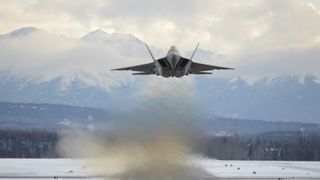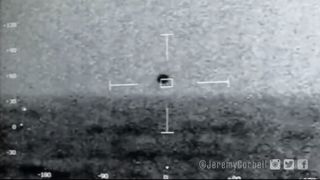Why are we seeing so many UFOs over America all of a sudden?
The U.S. military shot down three unidentified objects in a single weekend. Why are America's skies so filled with UFOs all of a sudden?

In the span of two weeks in February 2023, U.S. military pilots shot down four mysterious objects spotted over the United States and Canada.
The military identified the first of these objects as a 200-foot-tall (60 meters) Chinese spy balloon, floating approximately 60,000 feet (18,200 meters) over Alaska in late January; the government tracked the balloon for several days as it floated southeast across the country, eventually shooting it down off the South Carolina coast with a fighter jet on Feb. 4.
The other three objects — which include a car-size cylinder shot down over Canada's frigid Yukon territory and a strange octagonal object shot into the waters of Lake Huron — remain unidentified, and were all destroyed between Feb. 9 and 12. These three objects were less sophisticated than the spy balloon, White House officials said in a Feb. 13 press briefing, and floated between altitudes of 20,000 and 40,000 feet (6,000 and 12,000 m). However, they were flying in airspace used by commercial airplanes, which added to the security risk, government officials said.
These rapid-fire incidents have left many wondering why the government is suddenly detecting — and destroying — so many unidentified objects in U.S. and Canadian airspace. Are there really more objects up there than usual, or is the military simply getting better at tracking them?

While it's impossible to know for sure how many objects are in a given country's airspace at any time, government officials have been clear on one point: Following the detection of the Chinese surveillance balloon in late January, the military deliberately broadened its search for foreign objects at similar altitudes. That effort, apparently, has been a success.
"We have been more closely scrutinizing our airspace at these altitudes, including enhancing our radar, which may at least partly explain the increase in objects that we've detected over the past week," Melissa Dalton, the assistant secretary of defense for Homeland Defense and Hemispheric Affairs, said at a news briefing on Feb. 12.
In other words: After the military successfully tracked the spy balloon across the country for several days, they learned the best way to detect similar objects at similar altitudes that had previously gone unnoticed, Jack Weinstein, a professor of international security at Boston University and retired lieutenant general with the U.S. Air Force, told Live Science in an interview.
Sign up for the Live Science daily newsletter now
Get the world’s most fascinating discoveries delivered straight to your inbox.
"I think it all stems from the balloon," Weinstein said. "It appears to me that the military is just now figuring out how to track those items."
While the military has not yet identified any of the three objects subsequently shot down in February, both the U.S. and Canadian governments have suggested a "pattern" between these objects and the downed spy balloon, and declined to rule out the possibility that they are all part of a foreign spying effort. John Kirby, a spokesperson for the White House National Security Council, added in the Feb. 13 press briefing that China has been surveilling the U.S. with high-altitude spy balloons for several years — at least since the administration of former President Donald Trump — but that those objects had never been detected before now.
Meanwhile, China has claimed that the U.S. has flown spy balloons into its airspace more than 10 times since January 2022, National Public Radio reported.
A UFO culture shift

The strange incidents from early February are just the latest in a string of hundreds of encounters between U.S. military personnel and alleged unidentified flying objects (UFOs) — or unidentified anomalous phenomena (UAP), as the military prefers to call them — reported over the last several years.
In 2022 alone, Department of Defense officials opened investigations into 366 reported UAP sightings — 171 of which remained unresolved by the year's end, according to the first annual report of the All-domain Anomaly Resolution Office (AARO), a Pentagon office founded in early 2022 to investigate alleged UAP sightings by military personnel.
That single year's case load is more than double the 144 alleged UAP encounters reported by the military during the previous 17 years, according to a Pentagon report detailing UAP sightings between 2004 and 2021.
This huge increase in alleged UAP sightings may be the result of a "culture shift" within the military, Weinstein told Live Science, with military personnel less likely to feel stigmatized for reporting their strange encounters.
"The military may be transitioning to a culture where people aren't ridiculed for reporting unknown phenomena that maybe in the past they would be ridiculed for," Weinstein said, adding that his father — a radio operator on a WWII bomber — saw phenomena he could not explain, but did not feel comfortable reporting them.
"The culture now allows pilots to make those reports," Weinstein said.
Of the 366 newly opened UAP cases last year, 163 were resolved as "balloons or balloon-like entities," according to the AARO year-end report. Another 26 cases were identified as drones, while six more were identified as airborne "clutter," such as birds or plastic bags. Cases from prior years have also been attributed to weather phenomena and optical illusions.
Nowhere in the report are extraterrestrial aliens mentioned as a possible explanation for UAP. For Weinstein, this is no surprise.
"I would think that if you're smart enough to travel to Earth from another planet, you'd be smart enough not to get caught," Weinstein said.

Brandon is the space/physics editor at Live Science. His writing has appeared in The Washington Post, Reader's Digest, CBS.com, the Richard Dawkins Foundation website and other outlets. He holds a bachelor's degree in creative writing from the University of Arizona, with minors in journalism and media arts. He enjoys writing most about space, geoscience and the mysteries of the universe.
